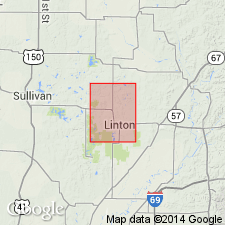
- Usage in publication:
-
- Shelburn formation*
- Modifications:
-
- Revised
- AAPG geologic province:
-
- Illinois basin
Summary:
Shelburn formation. As proposed by Cumings, included rocks in the interval from top of coal VII to base of Merom sandstone, thus including in upper part beds that had previously been included in West Franklin and Ditney formations. Upper part of Cuming's Shelburn formation has been separated from it by Shrock and Malott (1929) who restored name West Franklin formation to include two limestone members and the shale and coal between them and by Malott (1948) who restored name Ditney for formation overlying West Franklin and underlying Merom sandstone. Shelburn is here restricted to those rocks above the unconformity that overlies coal VII or locally cuts out coal VII and below base of West Franklin formation. Contains 250 feet of sandstone, shale, limestone, and thin lenticular coal beds, of which only basal part, approximately 30 feet, of Busseron sandstone member is exposed in Linton quadrangle. [Age is Late Pennsylvanian.]
Source: Publication; US geologic names lexicon (USGS Bull. 1200, p. 3564).
- Usage in publication:
-
- Shelburn Formation
- Dominant lithology:
-
- Shale
- Siltstone
- Sandstone
- Limestone
- Clay
- Coal
Wier, C.E., 1961, Stratigraphy of the Carbondale and McLeansboro Groups, southwestern Indiana: Indiana Geological Survey, unpub. ms.
Summary:
For more information, please contact Nancy Stamm, Geologic Names Committee Secretary.
Asterisk (*) indicates published by U.S. Geological Survey authors.
"No current usage" (†) implies that a name has been abandoned or has fallen into disuse. Former usage and, if known, replacement name given in parentheses ( ).
Slash (/) indicates name conflicts with nomenclatural guidelines (CSN, 1933; ACSN, 1961, 1970; NACSN, 1983, 2005, 2021). May be explained within brackets ([ ]).

